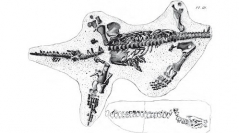

 Geodiversitas
32 (3) - Pages 377-390
Geodiversitas
32 (3) - Pages 377-390A historical specimen of plesiosaur, discovered by Mary Anning and kept in the Muséum national d’Histoire naturelle, Paris, under the number MNHN A. C. 8592 is here described. Discovered in 1824 by the first palaeontologist woman, Mary Anning, the specimen was sold by her to Constant Prévost who took it to Paris. Th is specimen is the second ever discovered plesiosaur and is here described for the first time even though it was figured by Cuvier (1825). The specimen is preserved in articulation and retained almost the entire post cranium but lacks the skull and most part of the neck. It preserves 56 vertebrae, most of the pectoral and pelvic girdles and most of the limbs. It was referred to Plesiosaurus dolichodeirus by Storrs (1997). Comparison with other specimens of Plesiosaurus dolichodeirus indicates that MNHN A. C. 8592 is an adult of advanced age. It reveals some unique features that may be attributed to ontogenetical and/or intraspecific variations. A better understanding of these variations among several individuals of the same species may help to clarify the problematic taxonomy and phylogeny of plesiosaurs.
Plesiosauria, Plesiosauroidea, Plesiosaurus, Lower Jurassic, England, intraspecific variation